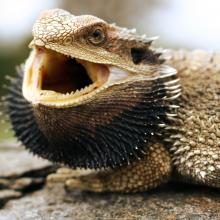Pogona vitticeps

Conservation Status:
Least Concern
Range:
Australia
Habitat:
Arid and Semi-arid Environments
Bearded Dragons are a species of lizard native to Australia. They get their name from a display where they can darken the scales under their mouth, resembling a beard. This display can be due to stress, danger, or competition, but it is also used in courtship.
Bearded Dragons are ominvores, eating both plant and animal material.
Within their habitat, bearded dragons seek out specific microhabitats that offer suitable conditions for thermoregulation and shelter. They often utilize rocky outcrops, crevices, and burrows to escape the extreme heat or cold and to find protection from predators.
One of the essential features of their habitat is access to basking sites. Bearded dragons are ectothermic, meaning they rely on external heat sources to regulate their body temperature. They spend a significant portion of their time basking under the sun on rocks or elevated surfaces, absorbing heat to warm themselves up.
When the temperature drops too low, Bearded Dragons can brumate, where they do not eat for weeks at a time and only occasionally drink water. They can also retreat to underground burrows when the temperature rises too much.
Female Bearded Dragons can lay 10 to 30 eggs in a single clutch. Similar to some other reptiles, the eggs' temperature determines whether the offspring will be phenotypically male or female.
Bird Kingdom cares for several Central Bearded Dragons (Pogona vitticeps)This species of Bearded Dragon is considered Least Concern as they have an extremely large range.
